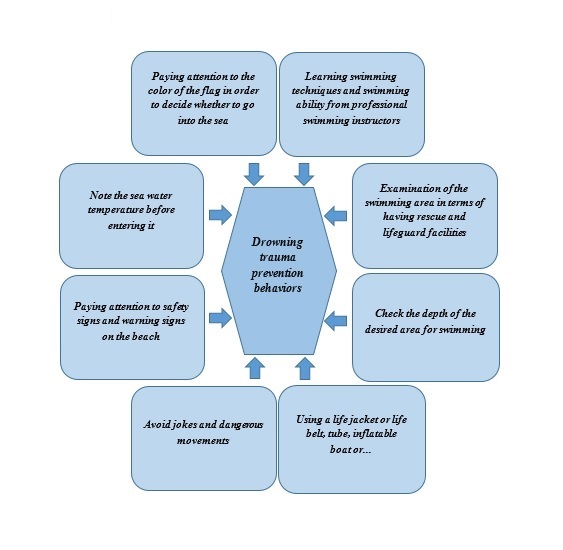Volume 13, Issue 1 (3-2023)
J Health Saf Work 2023, 13(1): 149-163 |
Back to browse issues page
Download citation:
BibTeX | RIS | EndNote | Medlars | ProCite | Reference Manager | RefWorks
Send citation to:



BibTeX | RIS | EndNote | Medlars | ProCite | Reference Manager | RefWorks
Send citation to:
Keikavoosi-Arani L, Ghahri A, Ehsani-Chimeh E. Using a Safety Management Approach to Investigate Predictors of Adopting Preventative Behaviors in Drowning Trauma among Students. J Health Saf Work 2023; 13 (1) :149-163
URL: http://jhsw.tums.ac.ir/article-1-6808-en.html
URL: http://jhsw.tums.ac.ir/article-1-6808-en.html
1- Department of Healthcare Services Management, School of Health, Research Center for Health, Safety and Environment, Alborz University of medical sciences, Karaj, Iran , leila_keikavoosi@yahoo.com
2- Department of Occupational Health and Safety Engineering, School of Health, Research Center for Health, Safety and Environment, Alborz University of medical sciences, Karaj, Iran
3- National Institute for Health Research (NIHR), Tehran University of Medical Sciences, Tehran, Iran
2- Department of Occupational Health and Safety Engineering, School of Health, Research Center for Health, Safety and Environment, Alborz University of medical sciences, Karaj, Iran
3- National Institute for Health Research (NIHR), Tehran University of Medical Sciences, Tehran, Iran
Abstract: (1055 Views)
Introduction: Drowning is one of the most prevalent accidents in aquatic environments. Although drowning has been noticed by healthcare policymakers in the world today, the issue of drowning has been neglected in the safety management of students. This research was conducted with the aim of investigating the predictors of adopting preventive behaviors from drowning trauma among students in the west of Tehran city with the approach of safety management.
Material and Methods: This study was descriptive-analytical (cross-sectional). The statistical population of this research included all parents of students who were studying in the first grade of the selected public schools in West of Tehran city in the academic year of 2021-2022 (N=3000). The random convenience sampling was used and 340 parents participated in this study. The data collection tool was a researcher-made questionnaire with a new approach to safety management (preventing accidents by doing preventive behaviors) based on a protection motivation model (preventive behavior model), of which reliability and validity were checked. Data analysis was done using SPSS 26 software and Pearson correlation test and linear regression.
Results: The constructs of the protection motivation model explained 67% of the variance of the behavioral intention of protection motivation and 69.7% students had no history of taking swimming classes. The highest correlation was between behavior and perceived costs (r=-0.579 and P<0.01) and 237 students (69.7%) had never exhibited preventive behaviors of learning swimming techniques or gaining swimming abilities from professional swimming coaches.
Conclusion: A significant relationship between the most constructs of the protection motivation model by performing drowning prevention behaviors, as well as the strongest correlation between preventive behaviors and perceived cost structure, emphasizes the design of free educational programs to increase students’ knowledge and motivation in the field of drowning prevention behaviors.
Material and Methods: This study was descriptive-analytical (cross-sectional). The statistical population of this research included all parents of students who were studying in the first grade of the selected public schools in West of Tehran city in the academic year of 2021-2022 (N=3000). The random convenience sampling was used and 340 parents participated in this study. The data collection tool was a researcher-made questionnaire with a new approach to safety management (preventing accidents by doing preventive behaviors) based on a protection motivation model (preventive behavior model), of which reliability and validity were checked. Data analysis was done using SPSS 26 software and Pearson correlation test and linear regression.
Results: The constructs of the protection motivation model explained 67% of the variance of the behavioral intention of protection motivation and 69.7% students had no history of taking swimming classes. The highest correlation was between behavior and perceived costs (r=-0.579 and P<0.01) and 237 students (69.7%) had never exhibited preventive behaviors of learning swimming techniques or gaining swimming abilities from professional swimming coaches.
Conclusion: A significant relationship between the most constructs of the protection motivation model by performing drowning prevention behaviors, as well as the strongest correlation between preventive behaviors and perceived cost structure, emphasizes the design of free educational programs to increase students’ knowledge and motivation in the field of drowning prevention behaviors.
Type of Study: Research |
Received: 2023/03/13 | Accepted: 2023/03/30 | Published: 2023/03/30
Received: 2023/03/13 | Accepted: 2023/03/30 | Published: 2023/03/30
Send email to the article author
| Rights and permissions | |
 |
This work is licensed under a Creative Commons Attribution-NonCommercial 4.0 International License. |







